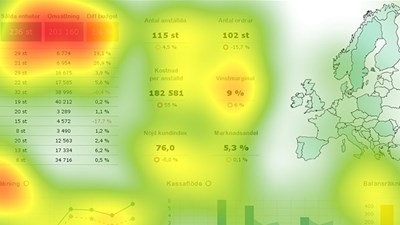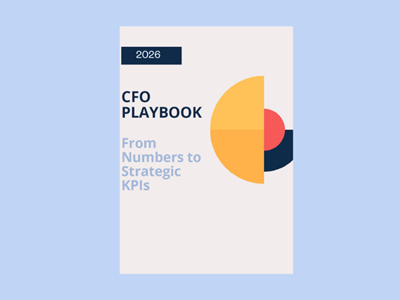.jpg?TS=638971488596265380)
The Hidden Cost of Data Silos in Financial Planning and Reporting
If you ever feel like your teams speak different languages when it comes to data, it is a classic symptom of data silos. The information gets stuck in one department, system or tool, making it difficult for anyone to see the full picture. Siloed data can affect different departments, from the sales team to HR and development.
In this article, we’ll break down why data silos happen, the problems they create and how you can finally tear down the walls to unlock smarter, faster and more connected decision-making.
What Are Data Silos?
Companies handle a large volume of data from different sources. If data is not properly managed, it can become isolated within separate systems, creating barriers between teams. These barriers are known as data silos.
When data silos exist, teams cannot easily share important information, which can harm data quality and integrity. Often, data is divided across different systems; structured data may be stored in data warehouses, either on-premises or in the cloud, while unstructured or semi-structured data may be stored in separate data lakes or specialised storage solutions.
This fragmentation makes it harder to get a complete, unified view of the organisation’s data. All these factors make data management complex and prevent organisations from fully leveraging the value of information.
Why Is Siloed Data Problematic?
With data silos, teams are unable to work with updated information, which often results in inconsistent and inaccurate data. On top of that, they waste time reconciling discrepancies, which slows down workflow. Other concerns that may arise are:
Blind Spots in Data
An isolated data system stores redundant or missing information, leading to inaccurate data reporting. Also, silos lead to inconsistent data analysis, which affects data quality and integrity.
Imagine a situation where a company’s treasury system records payments differently from the ERP integration systems. The finance team may report inaccurate cash flow. These gaps provide inaccurate reports and make it harder to plan and manage capital effectively.
Waste of Resources
When dealing with siloed data, the chances of having duplicate information are very high. This means the team must take extra steps to deal with it. This whole process of retrieving the lost data and using it again is time-consuming and costly. Instead of using the resources more efficiently, employees are left fixing data problems.
Imagine each department uses its own financial analysis and reporting software. The finance team must spend additional time and make efforts to collect data from multiple systems and fix errors. This duplication not only slows down reporting but also wastes resources that could be used for more important tasks.
Limited Collaboration
With siloed data, each team operates and communicates with its own system. Without shared access, it’s impossible to align goals and respond to market demands or new opportunities. The lack of visibility slows down communication, making it difficult for teams to be informed and connected. By integrating systems, departments will be aligned and financial reporting will be more precise.
How Does Siloed Data Occur?
The most common reasons silos happen are:
Organisational Culture and Structure
In many companies, teams often work in isolation, creating their own separate systems. This lack of coordination can lead to inefficiencies, as data is not shared between departments. It can result in limited access to information, duplicate data and increased costs.
Additionally, each department may rely on different tools to get work done. Without proper data integration, teams struggle to access the information they need, creating barriers to analysis and slowing down decision-making.
Resource Limitations
When teams don’t have the right skills or resources, integrating data becomes a challenge. Also, they often create quick, independent solutions just to meet immediate needs. Over time, these disconnected systems become harder to integrate, making it difficult to share information or maintain consistent data quality across the business.
Compliance and Regulations
Financial regulations don’t always specify how the data should be stored, so many companies adjust them to comply, accidentally causing data silos. For instance, storing budget and forecast data separately by department or region can break information, making it harder for finance teams to get a complete, consistent view for planning and reporting.
Business Growth
As a company grows, each department often works on its own strategy to meet the goals. Without a centralised data strategy, these independent strategies will store the information separately, causing silos. For example, when a company expands, finance teams work with their own tools. Without creating a unified solution, data ends up fragmented, making it difficult for more accurate forecasting.
How to Identify Data Silos
Companies can identify data silos in the everyday work environment. There can be concerns such as:
Limited access to platforms.
Spending too much time and effort compiling reports.
Missing or lack of data.
Reports with discrepancies or gaps.
To easily catch these problems, organisations should start examining how data flows across different departments. Also, they should look at how each team handles data, which tools they use and if they struggle to share information.
In finance, data silos often appear when accounts payable, accounts receivable and payroll maintain separate systems that aren’t connected. For instance, if AP data sits in one platform while AR and payroll are tracked elsewhere, it becomes difficult for the finance team to get an accurate picture of cash flow or create unified financial reports. Delays, inconsistencies and duplication are clear signs that silos affect financial planning and reporting.
How to Eliminate Data Silos
When a company spots data silos, it can take the next step – finding the best way to break them down. Here are practical tips to do that:
Transforming Data Operations
Transforming data operations with modern technology can prevent the creation of new silos by improving integration across systems, streamlining data flow and providing real-time insights.
For example, finance teams often manage data from multiple sources – tools, ERP systems and forecasting software. By moving this information into a cloud data warehouse and data lakehouses, organisations can unify their financial data. This will not only eliminate silos but also allow teams to access accurate finance information for reporting.
Data Policies and Standards
Strong data policies define how your data is collected, stored and used across departments. Being compliant with data standards ensures consistency and accountability, which is the foundation for better collaboration. This can help to break down silos and maintain data security and integrity.
In financial planning and reporting, for example, standardised data policies can ensure that budgeting and forecasting follow the same flow across departments. It easily and accurately collects reports for further analysis.
Adapting Teams to Changes
Organisations must provide regular training to educate teams on data accuracy. Implementing clear data protocols will help teams adapt to a culture that encourages collaboration and data sharing.
For example, retail companies often bring together marketing, sales and inventory teams under one data platform. By integrating sales trends, stock levels and customer behaviour, they create a single source of truth that helps optimise promotions, manage supplies effectively and improve overall profit.
Connecting Data Across Platforms
Promoting a unified solution across departments simplifies compliance and boosts collaboration and productivity between teams. All data must be shared through a centralised system to ensure consistency, accuracy and accessibility. When data flows seamlessly across platforms, teams can operate as one.
Extract, Transform and Load (ETL) tools help teams to share data. They can improve data by moving it from certain silos into a more centralised location, such as a data warehouse. On-premises ETL tools are hosted from the organisation’s site, while cloud-based ETL tools are offered by the vendor.
Data warehouses are built for quick access and analysis, not for handling daily transactions. This provides a full and clear view of the data.
Benefits of Breaking Down Data Silos
Once the silos are eliminated, it can positively affect the whole organisation and processes. Breaking down data silos ensures:
Data Consistency
Implementing a single source of truth ensures data integrity by allowing teams to have real-time insights into the finances. Instead of working on separate datasets, everyone, including stakeholders, can access the data while reducing errors, avoiding duplicate work and focusing on delivering more accurate reporting.
Optimised Workflow
When all the data is in one place, teams don’t waste time collecting information across multiple platforms. Collaboration becomes easier because everyone is working from the same dataset. This way, decisions can be made faster and projects will run smoothly.
Stronger Data Security
Centralising the data makes it easier to protect sensitive information. IT teams can implement consistent policies and protocols to avoid unusual activity that may increase the risk of breaches. This will ensure compliance with data standards and regulations and build trust with stakeholders.
Enhanced Customer Experience
When teams have access to complete and consistent data, they can better understand customer behaviour. They can respond faster to their demands and deliver solutions more accurately. These improvements increase satisfaction and loyalty in the long run.
Conclusion
Having data silos is a significant challenge for every organisation. It not only affects the work, but also the trust. Getting rid of them requires taking the right steps to improve decision-making and productivity. The most effective approach is to combine data into a single, unified source so everyone has access to the same information. By breaking down these silos, organisations can leverage the full potential of their valuable data.
Request a free demo with Mercur to learn how our platform can help you eliminate data silos and unify your financial data process.
 Blog
BlogBuild Long-Range Planning for Business Success
Discover how effective long-range planning aligns strategy, finance and operations for smarter decisions and sustainable growth.
 Blog
BlogMastering Spreadsheets
Where many businesses start small, a simple spreadsheet can adequately perform the limited tasks required of it. As the company grows, your spreadsheets can get more complex and harder to manage, by which point it feels like it will be too difficult to move to a different reporting tool.
 Blog
BlogHow to get accurate financial reports without waiting for month-end
You don't need to wait until month-end to see accurate financial reports. With modern financial systems you can access up-to-date reports whenever you need them.
 Blog
BlogFive tips for a successful budget process!
How can you make your budget process more successful and maximise the effort that was invested in creating it? Of course, there are many factors to consider but we’ve chosen to highlight five key areas that will enable and help you create a smoother, value-creating and collaborative budget process.
 Blog
BlogZero-Based vs. Incremental Budgeting
Budgeting sits at the heart of sound financial management. This is why choosing the right technique is crucial for CFOs – it shapes resource allocation, cost control and strategic agility. Incremental and zero-based budgeting are two leading methods that offer distinct approaches.
 Blog
BlogRolling Forecasts: Practical Steps, Benefits, and How to Get Started
Financial planning has changed. Traditional annual budgets can’t keep up with rapid shifts in the market, evolving customer needs, and internal performance dynamics. That’s why many finance teams are turning to a rolling forecast model.
 Blog
BlogA practcial guide to scenario planning
Scenario planning gives you a clear, practical way to test assumptions, spot risks and opportunities, and make better strategic choices so your organisation stays resilient when conditions change.
 Blog
BlogTop-Down vs Bottom-Up Budgeting
Budgeting aligns resources with strategic goals, and there are two primary approaches: top-down and bottom-up. Which method wroks best?
 Blog
BlogHow to Effectively Budget with Driver-Based Forecasting
Traditional models of forecasting rely on historical data and beliefs. It uses techniques that identify patterns, which are simple to use. However, with these methods, there are some challenges because they are not dynamic with today’s market, and can’t effectively analyse complex data.
 Blog
BlogBusiness Intelligence Reporting For Finance Teams
The real challenge today isn’t collecting data, it’s making sense of it and fast. Organisations turn to business intelligence (BI) to convert raw data into insight.But how do you actually do it right?
 Blog
BlogHow Automated Reporting Will Transform FP&A in 2026
This article highlights the power of report automation, how to implement it in your business and explores any new opportunities for accurate financial analysis in the long run.
 Blog
BlogWhat is Corporate Performance Management? (CPM)
CPM, or Corporate Performance Management, is a process within corporate management aimed at measuring and optimizing the performance of an organization. CPM encompasses a range of activities, including budgeting, planning, forecasting, reporting, and analysis.
 Blog
BlogAI in corporate budgeting
Artificial Intelligence (AI) can support decision making in key areas such as budgeting, capital allocation and even corporate strategy and as a result, it is increasingly being deployed in corporate performance management tools (CPM).
 Blog
BlogWhat Is FP&A? Definition, Purpose, and Best Practices
Without solid financial planning and analysis (FP&A), businesses operate in the dark. In this post we go deeper into the process of FP&A and why it’s important for businesses.
 Blog
BlogManagement Reporting Guide: Definition and Tips
Management reporting helps you see what’s really happening in your business. In this guide, we’ll explain what managerial reporting looks like and share practical tips.
 Blog
BlogHow do finance teams track KPIs across the entire organisation?
Learn how finance teams track KPIs across the entire organisation by consolidating data from multiple sources into a unified system like Mercur.
 Blog
BlogSpreadsheets are not Collaborative Tools
Spreadsheets were never designed for collaboration, yet they are the single most used program among teams and co-workers. They often start out as a quick document for storing, formatting or calculating information but evolve into important documents and are often the core records for an organisation.
 Blog
BlogHow EPM Transforms Financial Planning and Forecasting
Struggling to keep plans aligned in a changing market? Discover how EPM helps finance teams move faster, stay accurate and lead with real-time insights.
 Blog
BlogBoost Report Readability, Engagement, and Decision-Making
In today’s fast-paced business environment, effective reports and dashboards are crucial for decision-making. Our user study using eye-tracking technology revealed seven key insights into what captures attention.
 Blog
BlogFP&A Trends Shaping Financial Planning in 2025
Many organisations cope with fragmented planning and data quality issues, which slow down their forecasting cycles. This forces organisations to take practical steps to turn ambition into execution.
 Blog
BlogThe Powerhouse of EPM Tools
A business’s success heavily relies on having a strong strategy. However, what's even more important is implementing that strategy while tracking and measuring the performance. This can easily be done by investing in enterprise performance management (EPM) software.
 Blog
BlogWhy xP&A is a powerful game-changer
The newest iteration of planning, analysis and reporting systems is a powerful game-changer that unites company departments and boosts competitiveness. It’s called xP&A – the abbreviation of extended financial planning and analysis.
 Blog
BlogSpreadsheets Risk the Future of the Business
Spreadsheets often start as just a list for storing information and there is minimal process documentation, support or maintenance for these worksheets. Despite the fact that desktop applications such as Microsoft Office are included in the standard configuration of users' PCs, very little formal training is ever given to spreadsheet users.
 Blog
BlogHow to succeed with your planning, budgeting, and forecasting process
We know it can be challenging to succeed with your planning, budgeting, and forecasting process. Therefore, we have gathered our best tips for you to succeed!
 Blog
BlogFrom static budgets to agile financial management
Traditional budgeting has long been the cornerstone of financial planning in businesses. But today it can become more of a limitation than a strength. That’s where the concept of Beyond Budgeting comes in.
 Blog
BlogSave time and create a successful budget process
If you’re working in a large organization, you’re probably aware of how time-consuming the budget process can be. In this article we’ll give you tips on how to save time and still create a successful budget process
 Blog
BlogVariance Analysis: A Comprehensive Guide
Senior executives are demanding more detail in their management reports. The amount of data available to finance departments has exploded and decision makers see this as an opportunity to get more insight into how the business is performing.
 Blog
Blog3‑Statement Model for Better Financial Forecasting
Financial forecasting is critical for any business that wants to adapt to change. But finance teams keep usingfragmented models and manual processes. The 3-statement financial model is the solution.
 Blog
BlogBudgeting in a modern world
Thirty years after its debut, Microsoft Excel is still the preferred tool for budgeting and planning projects. However, its popularity is declining, due in most part to the rise of technology and subscription-based pricing for a myriad of SaaS-based products.
 Blog
BlogBest Guide to Improve Your Revenue with Flexible Budgeting
Optimise your expenses with flexible budgeting, and learn how to adjust budget to reflect current business activities, market changes and cost fluctuations.
 Blog
BlogAI in Financial Planning: Trends and Next Steps
Discover how finance teams are using AI to drive smarter planning, faster insights, and stronger business decisions.
 Blog
BlogWhat is management reporting?
Management Reporting refers to the process of creating, analyzing, and presenting information about various aspects of an organization's performance to enable decision-makers to make well-informed decisions about the future.
 Blog
BlogAI in Finance as a Powerful Tool
In this post, we explore how AI is evolving from a theoretical concept into a valuable resource for decision-making. Get useful insights for finance teams at any stage, from early exploration to actively using AI-powered solutions.
 Blog
BlogHow To Create a Successful Budgeting Process
When done well, budgeting helps organisations stay financially on course, even when things don’t go exactly as planned. Learn how to keep things on track so you avoid surprises and stay focused on your goals.
 Blog
BlogBalancing Profitability and Sustainability
Sustainability has become a central concern for organisations across the world — and the UK is no exception. This evolving landscape places new demands on financial reporting.
 Blog
BlogWhy is our Excel-based budget always out of date?
Excel creates outdated budgets. Every time someone enters a figure, sends a file, or waits for another department to finish their section, your budget falls further behind reality.
 Blog
BlogThe Role of the CFO: Top Priorities and Responsibilities
Today's finance leaders steer more than just budgets and reports. The digital transformation ramps up with the increase of corporate complexity, and so does the role of CFOs.
 Blog
BlogCash Flow Forecasting
Inaccurate cash flow forecasting can be a costly mistake for companies. In today’s volatile market, relying on static annual budgets or manual spreadsheets leaves financial leaders without the agility to respond to uncertainty.
 Blog
BlogBetter Revenue Planning
Sales forecasting is the process of predicting future revenue based on past data and trends. Read the blog to learn the best methods to do it right.
 Blog
BlogCFO Playbook - KPIs for 2026
The role of the CFO is changing fast. Today, the finance function is expected to deliver more than reports — it must drive direction, speed and profitability through clear, actionable KPIs. Learn more in this guide.
 Blog
BlogThe Collaborative, Smarter Budget
In many organisations manual budgeting processes over-burden staff and create masses of data which overwhelms department heads and stops them seeing the bigger picture.
 Blog
BlogHow can AI help CFOs make better decisions?
Artificial Intelligence (AI) has significant potential to enhance decision-making for Chief Financial Officers (CFOs) by providing data-driven insights, automating routine tasks, and enabling more accurate forecasts.
 Blog
BlogWhat Is Planning, Budgeting and Forecasting?
Planning, budgeting and forecasting are rarely static. Shifts in the industry often require you to revisit assumptions, adjust targets and adopt new processes. Learn how to strengthen your approach and stay ahead of change.
 Blog
BlogSpreadsheet Risk Management: Best Practices for 2025
Excel has long been a target for hackers; just one click on a malicious attachment can infect your entire network. So, how can you keep using spreadsheets while not sacrificing your safety?
 Blog
BlogTop 7 Manager KPIs for Financial and Operational Success
In today's post we'll break down why KPIs matter, which ones offer the most insight for finance and executive teams and how to ensure they're actually driving results.
 Blog
BlogInformed Business Decisions at Maximum Velocity
The ability to process information swiftly is essential. If your business can’t manage your data efficiently, your company’s financial performance will surely underperform. At Mercur we have developed our own database Veloxic which helps Financial Planning and Analysis.
 Blog
BlogRisks with working in spreadsheets
Spreadsheets are an essential tool for all types of organisations and businesses rely on them heavily, particularly for financial computations. The most popular spreadsheet program globally is, of course, Microsoft Excel, it’s used by an estimated 750 million people.
 Blog
BlogTop PowerBI Alternatives in 2025
Explore the top PowerBI alternatives for 2025. Discover how Mercur delivers integrated planning, budgeting and reporting without the high cost and complexity.
 Blog
BlogScenario Planning - Better control during uncertain times
Uncertain times create the need for more frequent forecasts and time for analyzing and comparing different future scenarios. We give you 5 tips on how to simulate future scenarios using scenario planning
 Blog
BlogThe Business Benefits of Integrated Business Planning
This blog explores what IBP is and the typical IBP process. We highlight business benefits and how the right software can be a game-changer for your organisation.
 Blog
BlogBusiness Budgeting Software: How to Choose the Right One
Choosing budgeting software is partly a finance and partly a strategic decision. The right tool helps organisations organise planning cycles, adapt as the market changes and increase accountability across departments. But not every platform will be a good fit.
 Blog
BlogAI and Machine Learning, what is it, and why is it important for the future?
Artificial Intelligence and Machine Learning, what is it, and what is the difference?



















































